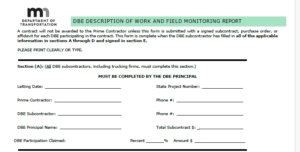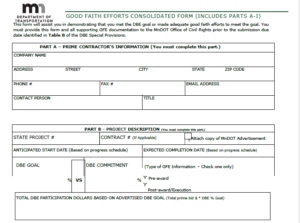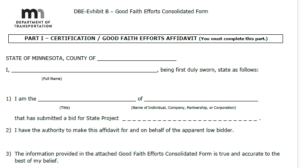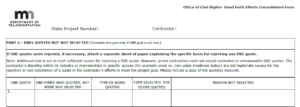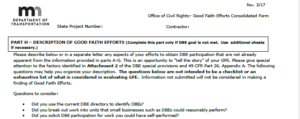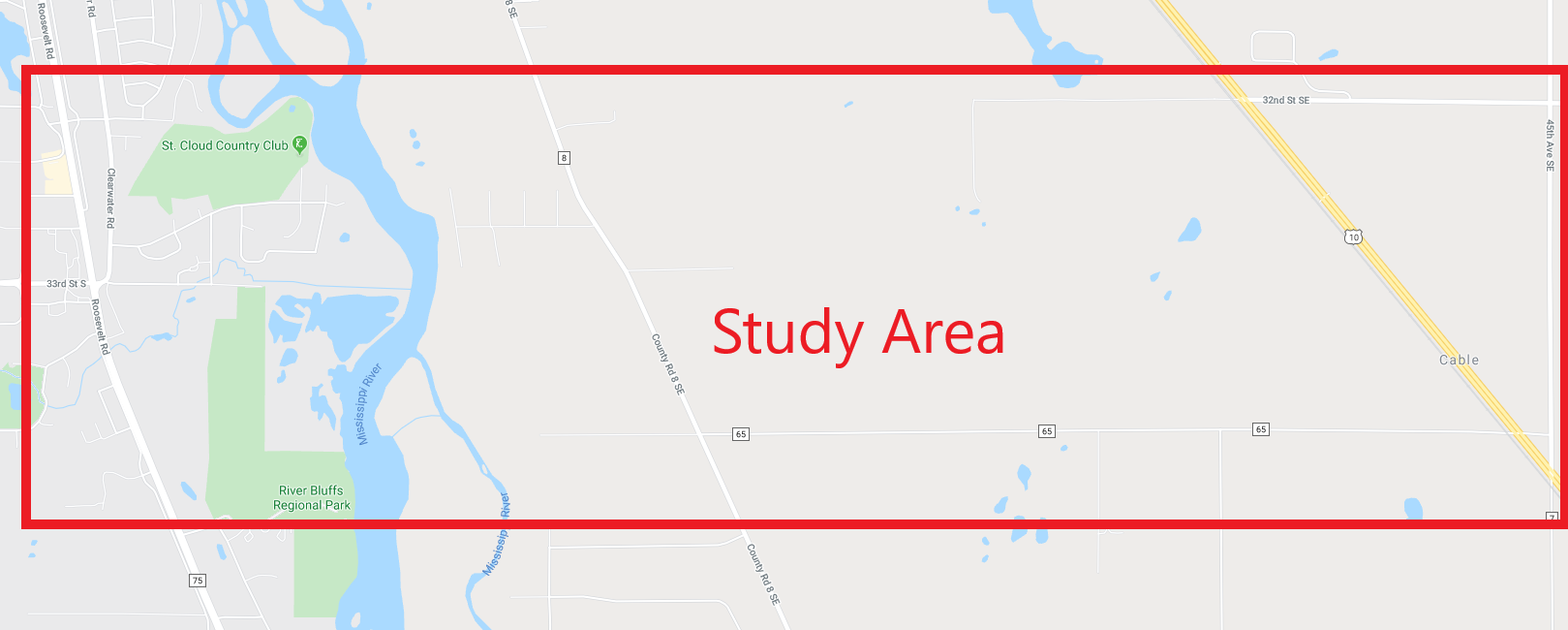The last planning effort for a potential Mississippi River bridge crossing in south Saint Cloud ended in 2023. The corridor is envisioned as part of an urban beltline arterial encircling the metropolitan urban area core.
Growth is occurring west and east of the Mississippi River. Ideally, property owners, developers, cities, townships, and counties should be accounting for the “preferred alignment(s)” in their land use planning decisions. This effort to complete an Environmental Impact Statement will allow official mapping of the corridor by identifying potential economic, political, social, and environmental consequences of potential alignments. It is possible that one or more new, viable potential alignments may be identified as part of this process.
2023 Study Deliverables:
Previous Planning Studies & Analysis
2045 Urban Beltline Model Results
Questions & Answers Regarding the Request for Proposals
- Q1: How many teams were shortlisted, and are you expecting to conduct interviews?
- A1: Three teams were shortlisted. We do not expect to conduct interviews.
- Q2: Is preparing an official map and going through that approval process part of this scope?
- A2: Preparing the official map is part of the scope and an expected final deliverable. Taking it through the approval process is not necessarily an expected part of the scope. But if anyone feels they have sufficient time and budget to take it through the approval process, they are certainly welcome to propose it.
- Q3: How many alignments are assumed to be studied in the Tier 1 EIS?
- A3: As many as necessary to satisfy regulators.
- Q4: Are the requested hours per person expected in the body of the proposal, or with the sealed cost estimate?
- A4: Hours per person is expected to be part of the sealed cost estimate. But if someone wants to note it in the body of the proposal, they are welcome to do so.
- Q5: The RFP references Sample Work Plan as Exhibit B, but we did not see it attached. Can you please provide?
- A5: Ooops! Yes, totally my fault. A sample price plan can be seen by clicking HERE:
- Q6: Funding – Do the Congressionally Directed Spending funds contain any requirement which would affect our approach or schedule? IE, specific deliverables, daylight/sunset dates, other time-related criteria, etc.?
- A6: To the best of my knowledge, FHWA and MnDOT are treating these funds just like any “normal” funds from USDOT. To wit, they must be obligated no later than 2026, but there are no other schedule-impacting requirements of which I am aware. Regarding requirements for project approach, there are the “normal” requirements – Equal Employment Opportunity, Clear Air Act, Debarment and Suspension, Byrd Anti-Lobbying Amendment, Drug-Free Workplace, Buy America requirements, Title VI, etc. – but I am not aware of any additional or “special” project approach requirements at this time.
- Q7: Schedule – Assuming there is no time restrictions associated with the question above, we are concerned with the start to finish dates identified in the RFP. Typically, FHWA allots a two-year time frame to complete a Tier 1 EIS, and this often difficult to achieve due to the many dynamic features of the environmental process, agency coordination, and agency review timelines. This two-year time frame starts with an official Notice of Intent (NOI) and ends with a Record of Decision (ROD). To achieve the EIS within two years, there are tasks that can be accomplished in advance before the “clock starts ticking”. These tasks help kick start the EIS process. Once the ROD is received, then the official map could be developed and the procedural exercise of getting approved could continue prior to the onset of Tier 2 work. To provide a comprehensive analysis to obtain your goals, is the APO open to a modified schedule?
- A7: Of course. As the RFP states, we want you to bring your knowledge and experience to the table and propose the best process as you see it.
- Q8: The RFP states, “The firm must sign the original proposal and any required certifications or affidavits in blue ink.” Is it acceptable to have electronic signatures, or do they need to be wet-inked?
- A8: This bit of language is left-over from pre-electronic signatures. What is important is that the signatures are legally binding. Wet signatures ALWAYS work. Electronic signatures must meet certain requirements to be legally binding.
- Q9: The RFP states, “submit the original and five copies of the proposal.” Since the cost is requested in a separate sealed envelope, do you want 1 copy of the cost or 6, like the technical proposal? Along with the printed copies, would you also like an electronic copy of the proposal on a USB?
- A9: 1 copy of the cost proposal should be sufficient. An electronic copy of the proposal would be useful as I will be distributing it to other members of the evaluation committee.
- Q10: Can you please confirm which forms we need to include for the DBE goal? At the top of page 6 in the RFP, it states, “The MnDOT Office of Civil Rights has assigned a 12% DBE goal to this project. Bidders are directed to read Exhibit C and Section F of Exhibit D.” Should this be Exhibit B and not Exhibit C? There isn’t a Section F of Exhibit D; should this be in reference to another part of the RFP?
- A10: This confusion is a product of me forgetting to add the Sample Cost Plan exhibit (see previous question and answer), which SHOULD have been Exhibit B, and then the DBE Special Provisions SHOULD have been Exhibit C. So, yes, you should read all of Exhibit B to educate yourself on the DBE requirements. Likewise, “Section F of Exhibit D” is intended to refer to Section F of Exhibit C in this proposal.
- Q11: At the top of page 6 in the RFP, it states, “The DBE Special Provisions (Exhibit C) explain how to comply with the DBE requirements. In particular, see the text regarding documents that a bidder must submit with its bid proposal. The form required in the bid can be found on the last page of Exhibit C.” The DBE Special Provisions is Exhibit B and not Exhibit C. There also isn’t a form on the last page of this section (Exhibit B). Can you please confirm which form we need to include in our submittal?
- A11: See answer to question 13 below:
- Q12: If an electronic submission is used, should the “sealed cost estimate” be sent separately or be password protected?
- A12: Send it separately
- Q13: The DBE forms read like they are submitted after the award and then the RFP states “In particular, see text regarding documents that a bidder must submit with its bid proposal. The form required in the bid can be found on the last page of Exhibit C.” The submission due date is the 5th calendar day after the successful responder is notified by MnDOT. There is no form at the end of Exhibit C. Can you please clarify exactly which DBE forms need to be submitted with our proposal?
- A13: In general, the DBE process in play here is the standard Minnesota DBE process. Specifically,
-
- To those ends, if you are successfully able to involve a DBE firm, you will need to submit the “DBE Description of Work and Field Monitoring Report”, page 29 of the RFP for each DBE participating in the project. It looks like this:
-
- Also, you will need to submit Parts A, B, and C of the Good Faith Efforts Consolidated Form, (page 32) which looks like this:
-
- Also, Part D (page 33):
-
- And also, Part E (page 34):
-
- And finally Part I (page 38):
-
- Regardless of whether or not a DBE firm is included in the project team, the State wishes to know that you have at least made a good faith effort to include a DBE in the project. To that end, if the DBE goal is not met, you will need to submit Parts F, G, and H of the Good Faith Efforts Consolidated Form, (pages 35, 36, and 37) which look like these:
- Q14: Do we need to resubmit the Required Affidavits & Certifications as submitted with the SOQ?
- A14: If you have already submitted the required signed affidavits and certifications, there is no need to resubmit, but please note in your proposal that you have previously submitted them.
- Q15: Please confirm if this contract is subject to MnDOT’s overhead rate cap. Also, is there a fixed fee percentage you would like all teams to use for purposes of the cost estimate?
- A15A: There is nothing that limits the contract to MnDOT’s overhead rate cap. However, MnDOT will conduct a pre-award audit to determine if the costs for services are reasonable in relation to the services rendered.
- A15B: Regarding the fixed-fee percentage, if you are giving me the choice, I would choose 0%. But that doesn’t seem likely or even fair. Just remember that this process is competitive. And while costs are not part of the evaluation process, the more you want in fixed-fee, the less work you will be able to do on our behalf. A competitor with a lower fixed-fee will be able to do more work on our behalf. And since we are selecting based on the best value to us, well…it’s easy to see how that decision would be made.



